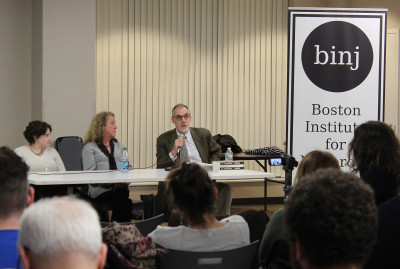
The Boston Institute for Nonprofit Journalism hosted a panel Tuesday about gentrification in the developing Barry’s Corner area of Allston, exploring interactions between Harvard University, the Boston Redevelopment Authority and the community as gentrification continues.
Emily Hopkins, projects coordinator for BINJ, moderated the panel, which was based on a BINJ article by Rachel Hock regarding the historic pattern of gentrification in Allston.
“[The story] talks a lot about the plans the Boston Redevelopment Authority had during the ’60s,” Hopkins said. “Everybody knows about urban renewal in the West End, but it turns out that there was lot of stuff going on in Barry’s Corner. Harvard also has a hand in the development of the area. They own more land in Allston than Cambridge at this point.”
Hock, an Allston resident and freelance writer from DigBoston, talked about Annie Soricelli, an activist who lived on North Harvard Street in the 1960s and who is featured in the article.
“The BRA let the residents know that they were going to be tearing down all of their homes to build luxury apartments,” Hock said. “Annie protested. There were copies of the letters sent to the residents, copies of one the sent to Annie Soricelli, with her name misspelled, demanding that she buy back her house that they had taken.”
Hock also commented that Boston has largely left the community in the hands of Harvard, which contributes most of the money the community receives.
“It’s almost like the city relies on Harvard to take care of this area, then they don’t have to,” Hock said. “That leaves us with really no recourse. We don’t have any way to fight back. We don’t have any bargaining chips because Harvard is going to do the development.”
However, Jim Vrabel, a panelist who wrote “A People’s History of the New Boston,” said cities no longer have the resources to maintain communities like Allston.
Despite the problems between Harvard and the Allston community, the panel members said there is hope for the relations between the two groups.
Vrabel mentioned that in the ’60s, Harvard undergraduates were allies for Allston residents suffering from the expansion of the university into the neighborhood.
Joyce Radnor, the third member of the panel, from the Allston Construction Mitigation Subcommittee of the Harvard Allston Task Force, said Allston and Harvard’s relationship could be stronger if they just saw each other as neighbors.
“The thing that Harvard can do, should do, needs to do, is just spin the focus or spin the perspective on its axis so that they can really become our neighbors, that they don’t become an institution taking over a neighborhood, but they became neighbors,” Radnor said. “If Harvard could just become a neighbor instead of an invader, it would change the entire dynamic.”
Quinn Mulholland, a 19-year-old who attends Harvard, said sometimes the administration can have a hard time hearing the voices of people in the community.
“Gentrification is definitely an issue,” he said. “In my experience, shops and amenities that cater to students are very different from places that cater to members of the community, and that might definitely be a source of frustration for people who are already living in Allston.”
Several attendees said they hope to alleviate the problems taking place in Allston.
Daniel Schiffer, 24, of Allston, said he attended the panel because he wanted to be more involved in the community he has lived in for close to six years.
“I run a music website in the area called Allston Pudding, and that’s sort of been my community involvement up till this point,” he said. “I figured it would be a cool thing to check out to learn more about the community I’ve spent so much time in and that I call home. I wanted to come and see if I could engage more in the community in a different way.”
Carrie Spadine, 24, of Allston, mentioned how clear the issue of housing prices is for the neighborhood of Allston.
“It’s been really clear to me since I moved here that low income and even reasonably priced housing is a massive issue in the area that not very many people are really addressing,” she said. “For this particular neighborhood, where development is about to come in and drastically change the affordability landscape, it seems like optimal time to get involved and start addressing these issues.”




